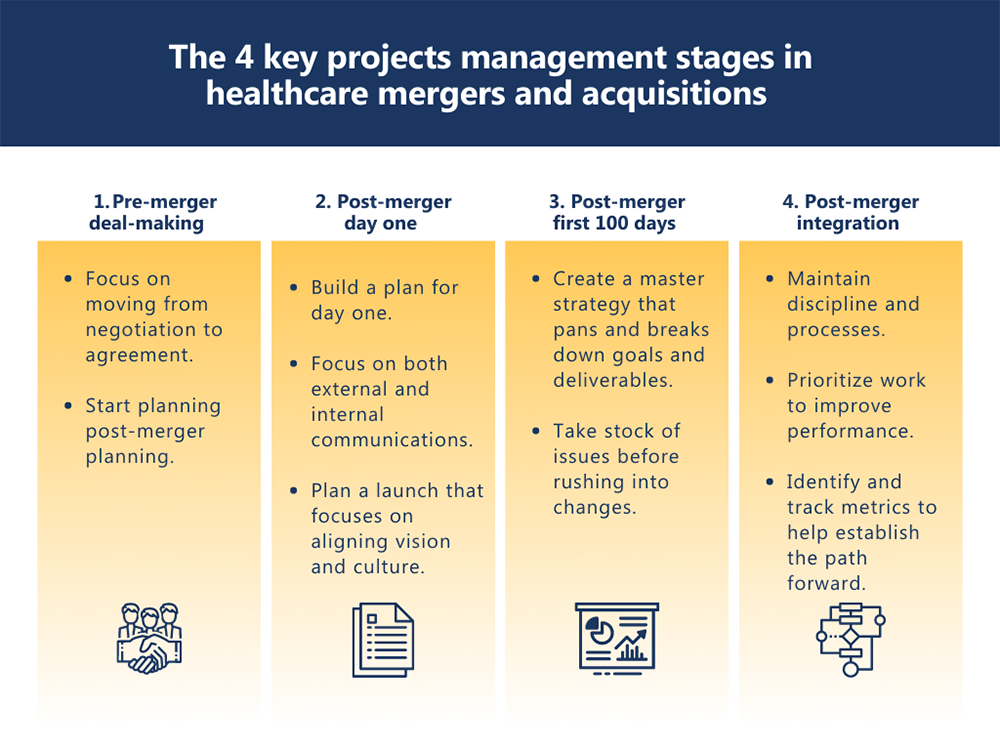Recent years have seen the trend of healthcare mergers and acquisitions continue to grow. In 2020 at least ten “mega mergers” (i.e. mergers with at least $1 billion in annual revenue) were announced in the U.S. alone. Evidence of smaller hospitals joining hospital systems continues to escalate, with a report by Deloitte indicating that nearly 60% of hospitals in the U.S. are part of a health system.
The prevalence of such deals continues to present challenges and opportunities for organizations, both big and small. Handled well, they can lead to unprecedented opportunity and growth. Handled poorly, they can lead to administrative chaos. In any deal, there are steps both parties take that ensure success in these transactions.
The first step is to stop referring to mergers as a “transaction”, a word that paints the merger as a singular event to be stamped and dated. Changing mindsets begins with the terms used by our organizations, and it’s essential to treat deals of this magnitude as an ongoing process that requires buy-in at every level of organizations to be successful.
Healthcare mergers and acquisitions impact all aspects of standard operations, and it’s important to recognize this to avoid an onslaught of administrative issues, which will ultimately impact patient care. There are many benefits to mergers and acquisitions for both parties, but only if an appropriate strategy or checklist is in place to manage the aftermath.
Four secrets to healthcare mergers and acquisitions success
1. Don’t underestimate leadership’s impact on healthcare mergers and acquisitions success
Leadership teams need to prepare a plan which allows for a smooth transition and adequate change management. An appropriate program allows your team to make sure patients continue to receive the care and services they need. Without this in place, the organization can falter, and patients may get caught up in the mix.
In 2017, Deloitte analyzed the impact of mergers and acquisitions on a hospital’s performance and reported commonalities between leadership teams that succeeded and those that struggled. Below is a list of traits that successful leadership teams exhibited.

Successful M&A healthcare leadership usually have the following in common:
- Develop a strong strategic vision for pursuing the merger and acquisition activity
- Set clearly defined financial and non-financial goals to be achieved through the process
- Held the leadership team accountable for integration efforts pre- and post-merger
- Unify culture by investing in change management
- Convey decisions clearly on executive and mid-management leadership
- Align clinical and functional leadership early in the process
- Follow best practices for integrating the acquired or merged organization into the parent organization
- Implement project management best practices that allow for the tracking of targets and milestones from day one of the merger and acquisition
2. Establish a governance committee that includes your best project management talent
Healthcare is one of the most regulated industries globally, and creating a culture of compliance is one of the keys to successfully merging two organizations. It’s wise to designate roles for governance and establish compliance standards early in the process.
Establish a committee accountable for complying with all rules and regulations as your teams work together to consolidate operations and finances. Some healthcare organizations can be tempted only to include c-suite employees, but it’s best practice to include effective project managers in the mix. It will be essential to have critical voices from across both organizations to get a clear picture of challenges and roadblocks as they arise.
This committee will be instrumental in addressing barriers to success and will require the support of executives from all levels of both organizations. Because of the many moving parts involved, project managers are often uniquely positioned to give realistic projections and timelines based on current workloads and capabilities. They’re also aware of challenges and struggles on the ground floor that might not always make it to the c-suite level.
You may want to hire additional project managers to help. It’s also possible that the talent you need exists within the merging organizations. Task these individuals with setting up processes that will enable stability for years to come. The governance committee should ultimately be held accountable for the merger’s success. They can break this down into four key stages: pre-merger deal-making, post-merger day one, post-merger first 100 days, and post-merger integration.

3. Prioritize the conversation about post-merger ERP integration
After any healthcare merger, ERPs often become one of the central topics of conversation, but this is often too little, too late. If you’re only starting to talk about this on day one, your team will likely face administrative challenges. Not least, that first month’s close where they will need to consolidate financial statements for the first time. Without adequate technology in place, this will be time-consuming and riddled with errors from manually transferring data between systems.
It’s usually better to start planning for the effective integration of software long before kick-off. The ERP is central to how any healthcare organization operates, and it’s almost impossible to succeed if you postpone finding the right solution and aligning all parties on how to use and manage processes within it.
Best practice would dictate that a centralized ERP solution with advanced security options is the best fit for securing data from multiple entities post-merger. It allows you to consolidate financials easily and manage the supply chain across the entire organization, giving you actionable insights into performance.
Prioritizing ERP integration is not a step unique to healthcare organizations. This blog on why you need to worry about post-merger ERP integration now offers further insights into the impact this crucial step can make.
4. Unify culture by investing in change management
Often it is assumed that change and project management are somehow the same. However, change management concerns itself more with the cultural aspects of the merger and acquisition process. An effective change management strategy helps deliver insights on how people in both organizations feel about the merger and then use these insights to build a culture that unites the organizations.
It’s rarely a good idea to imprint the parent organization’s culture on the smaller organization, so this is a role that requires a tremendous amount of tact and empathy. Ideally, change management should help identify and diagnose gaps between the two organizations and resolve these differences through measurable initiatives, creating a culture that serves the future of the merger. There are several ways to invest in change management. Within the Microsoft community, both ProSci and the ADKAR model come highly recommended.

The 4 stages of culture change in healthcare acquisitions and mergers
- Mapping the vision is all about setting the direction for the future of the organization. Usually, this is achieved by defining the desired outcomes and then prioritizing these to create a path forward. This stage often requires taking a step back and aligning teams on vision, priorities, and culture.
- Energizing the organization requires crafting compelling messaging to get buy-in from people at all levels of both organizations. It’s a critical stage that aligns expectations around culture and making strategic decisions around any pushback. It’s essential to think of change management as a constant conversation and embrace back-and-forth during the journey.
- Hardwiring cultural changes can take time. It requires attention to detail and consistent documentation and training around processes, policies, and governance. Most people will likely have questions, so this is often best broken down into phases or stages to help employees adjust to each level of change. It’s also an important step to identify anything blocking progress and work to tap into the full potential of your teams.
- Driving execution of new initiatives is key to supporting cultural change. After launch, it’s vital that your organization can identify, measure and improve progress as the two cultures unite.
In conclusion
Although it is possible to manage the complexity of healthcare mergers and acquisitions, some organizations still struggle to meet the administrative demands of the process. This blog hopefully serves as a jumping-off point to help your team navigate the transition and enable you to advocate for the resources you will need.
Further reading for healthcare administrators:
- The complete guide to financial management for healthcare
- The rise of administrative challenges healthcare faces
- Why security is key when it comes to your healthcare ERP
- Unlock the secrets to healthcare mergers and acquisitions success
- Creating a culture of compliance in your healthcare organization


